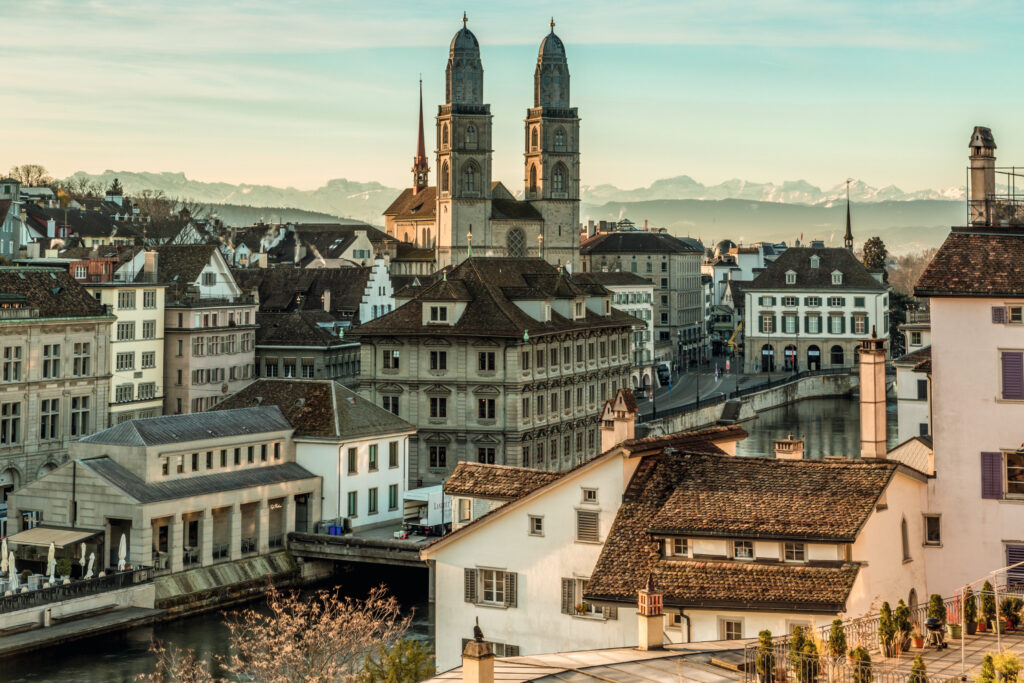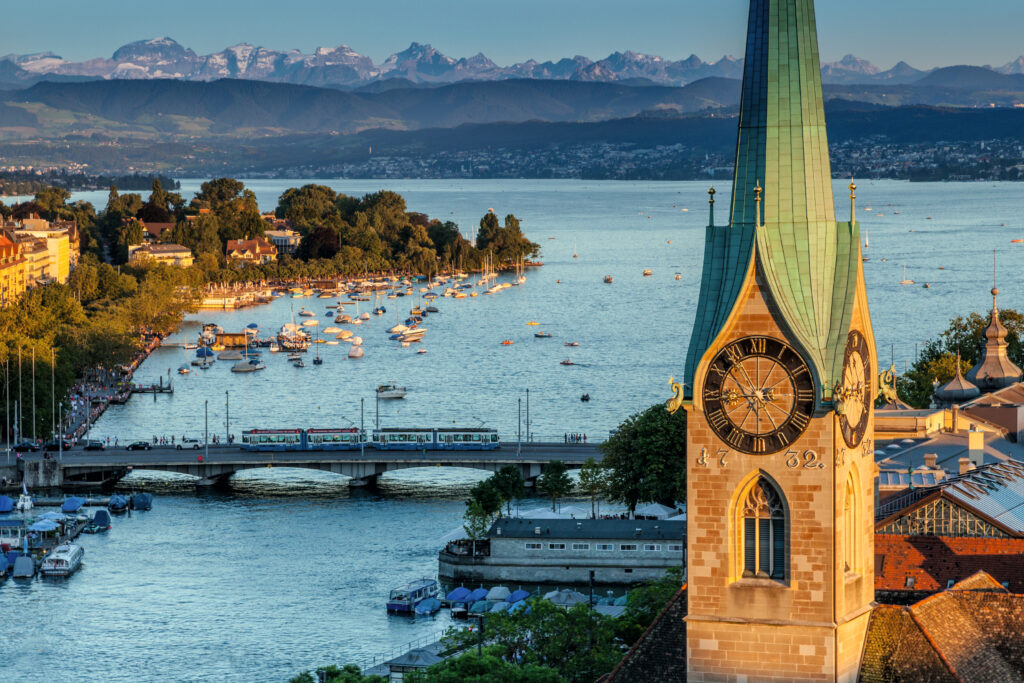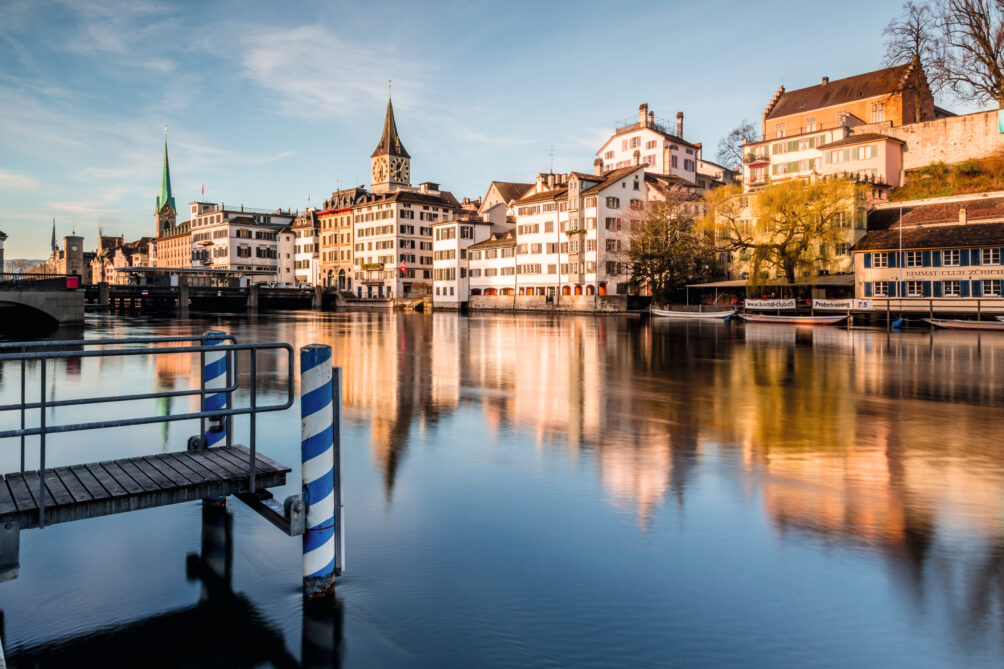Zurich may be the financial capital of Switzerland but here’s a thing – more people work in the arts in the city than banking. And it’s a pretty cool spot, a hotbed of culture and revolutionary zeal during both world wars, when exiled artists, writers and avant-garde intellectuals took refuge here, among them Irish writer James Joyce, who wrote the world’s most famous novel, Ulysses, in the city.
For his last night out in Zurich, Joyce went to the Kronenhalle bar. Three days later, on 13 January 1941, he was dead, following surgery on a perforated ulcer. He’s buried in Fluntern Cemetery beside Zurich Zoo, the final stop on the tram line. The journey is a steep one, up some of Zurich’s prime real estate hills, past detached mansions on leafy streets with stunning views. Joyce was fond of the Zoo’s lions and when he was buried his wife Nora said she liked to think of him lying there listening to them roar.
The Kronenhalle was also a favourite with designers Coco Chanel and Yves Saint Laurent and artists Marc Chagall and Pablo Picasso, whose art can still be seen on the walls alongside works by Miro, Matisse and Klee. Today it’s as much art gallery as bar and restaurant – expect to pay around £18 for a cocktail and double that for a main course. Zurich may be cool, but it certainly isn’t cheap.
Opposite the Kronenhalle, the Café Odeon, founded in 1911, was another home away from home for emigres such as Joyce, Lenin and the Dadaists, who were founded in Zurich. These days, with its marble topped tables, red banquettes and Art Noveau vibe, it’s a smart spot for food and drinks – try the 2-course set menu lunch, around £23.
Located in ‘Bellevue – ‘beautiful sight’, the area is a good place to start exploring Zurich’s Old Town, where the river Limmat meets Lake Zurich under the Quaibrucke – Quay Bridge. These crystal-clear waters are clean enough to swim in and many people do. Close by the bridge, the Frauenbad – ‘women’s baths’ – is an area traditionally reserved for women with a covered-in section for privacy.

Following the Limmat along to where it merges with the river Sihl, in pretty Platzspitz park beside the National Museum, I find another of James Joyce’s favourite places. Mentioned in Finnegan’s Wake, “legging a jig or so on the Sihl”, it’s where he had his favourite photograph taken, standing facing the river. Today the rivers’ names are inscribed on the wall as Ljmmat and Sjhl – the ‘j’ replacing ‘i’ in his honour.
Along the river, the Fraumünster, ‘women’s church’, with its Marc Chagall stained-glass windows was built on the site of a 9th century women’s abbey and faces the Grossmünster, with its soaring Romanesque twin towers, dating back to the 1100s. The shady Lindenhof with its 52 lime trees and river views is home to the 9th century St Peter’s church, with its distinctive tower and the largest clock face in Europe. Celts, Romans and Ottonians once made their homes here, now it’s a good spot to play a game of chess on giant boards with life sized pieces.

For a more contemporary look at the city, take the number 4 tram to Zurich West, the city’s former industrial area, now home to its cool cultural quarter, where theatres, galleries, museums and artist studios have replaced factories and shipbuilding yards. (The tram is known locally as Zurich’s design and cultural line, as it passes by all the city’s major cultural institutions.)
I’m staying in some luxury at the Storchen Hotel, with its elegant riverfront cocktail bar and upstairs, a restaurant terrace overlooking the water and soaring Grossmünster towers. From here, I watched the sun go down over a Michelin-starred dinner of scallops, oysters and ravoli, accompanied by several amuse bouches and some of the hotel’s own Chardonnay. Across the water people were dining on outdoor terraces and picnicking by the river’s edge, the Alps rising in the distance.

The next morning, I woke up to a view of swans bobbing on the Limmat and breakfasted on eggs from the hotel’s hens. They live on a farm at the lake, near the Stochen’s sister hotel, the Alex, which I could travel to by private riverboat if I took the notion.
If you’re not up for Michelin dining, you’ll find lots of great foodie alternatives. Zurich is big on responsibly sourced ingredients and also home to the world’s oldest vegetarian restaurant. Open since the 1880s, Hilel is currently run by the fourth generation of the family who founded it. Main courses from £20-£25.
And, of course, there’s chocolate (you didn’t expect me to visit Switzerland and not mention chocolate). Lindt’s Home of Chocolate – producing the good stuff since 1899 – is a 20-minute journey from Zurich, where you can take a tour of the museum and visit the biggest Lindt chocolate shop in the world (Admission £13 adults, £9 children, Lindt-home-of-chocolate.com).

When you’re done with culture (and chocolate), you can be in the countryside (with chocolate-coloured cows) in under 20-minutes, with all of the Alps to explore. Whether it’s a starting point for your Swiss tour or a city destination, there’s a lot more to Zurich than banks.
CONTACTS AND PRICES
The Storchen Hotel is a member of the exclusive Preferred Hotels and Resorts group, rooms from £380; Preferredhotels.com. For more information on Zurich, visit Zuerich.com and MySwitzerland.com. A Swiss Travel Pass, from £186 for 3-days, offers unlimited travel on the country’s rail, bus and boat network, Mystsnet.com.

